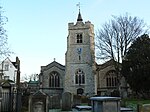Duke of Sussex, Acton Green
Buildings and structures completed in 1897Buildings and structures in ChiswickGrade II listed buildings in the London Borough of EalingGrade II listed pubs in LondonPubs in the London Borough of Ealing

The Duke of Sussex, Acton Green is a public house, opened in 1898, in the northern Chiswick district of Acton Green. It is prominently situated on a corner facing the common. The Grade II listed building is "elaborately decorated" to a design by the pub architects Shoebridge & Rising.
Excerpt from the Wikipedia article Duke of Sussex, Acton Green (License: CC BY-SA 3.0, Authors, Images).Duke of Sussex, Acton Green
South Parade, London Acton (London Borough of Ealing)
Geographical coordinates (GPS) Address External links Nearby Places Show on map
Geographical coordinates (GPS)
| Latitude | Longitude |
|---|---|
| N 51.4963 ° | E -0.2641 ° |
Address
The Duke of Sussex
South Parade
W4 5LF London, Acton (London Borough of Ealing)
England, United Kingdom
Open on Google Maps









